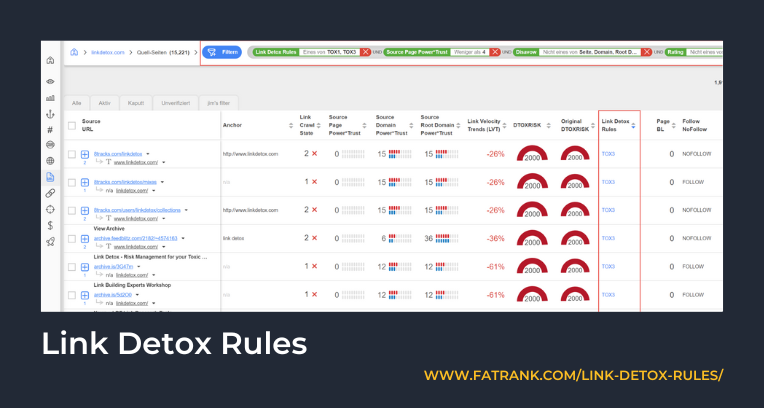
Link Detox Rules
Not only does LinkResearchTools provide the Best Link Data in April 2025, but it has some amazing automated rules you can set to help you speed up the disavow file creation.
Link Detox is software that automatically rates links based on automated rules. Link Detox helps you assess all your backlinks, recover from Google manual penalties, protect your website from future penalties, and build new strong links.
It is important to use LRT certified experts to analyse and recover and protect your rankings from Google Penalties and Manual Actions.
In our Link Detox Rules guide, we explain all the tags used within the amazing LRT link analysis tool.
Contents
Link Research Tools Tags
If you order a Link Audit you will receive an Excel Spreadsheet with a lot of data about your links.
The link audits use Link Detox rules from the data analysis inside the LRT tool.
The Link Detox rules analyse each link that contributes to the overall risk of a backlink profile.
Link Detox rules have their own risk rating value and are included on the link audit spreadsheet under the column called ‘TAGS’.
The TAGS explain why a link was disavowed, rated as being toxic or labelled as safe.
Here are some commonly used TAGs on link audit spreadsheets:
TOX1
The Link Audit tag TOX1 means the domain is not indexed in Google – often a sign for a Penalty.
A TOX1 could mean that Google has de-indexed the site due to a Penalty.
There could be other reasons for websites not being indexed like it is a new site or having problems with the robots.txt.
A domain that is not indexed in Google won’t help you SEO-wise so removing it is the better option if in doubt.
A TOX1 link detox rule usually places all the backlinks into the disavow file.
TOX2
The Link Audit tag TOX2 means the domain’s theme is listed as dangerous (Malware, Malicious or Virus).
Any domains listed as dangerous with possible malware, malicious activity or a virus, are classified as a bad neighbourhood under the TOX2 link detox rule.
Backlinks pointing to your site with TOX2 tags may automatically assume that you are connected to this bad neighbourhood by Google algorithms.
A TOX2 link detox rule usually places all the backlinks into the disavow file.
TOX3
The Link Audit tag TOX3 means the link is calculated as a High DTOXRISK score, classified by the Link Detox Genesis algorithm as unnatural.
The High DTOXRISK score is an automatic evaluation and calculation based on a large number of data signals and user ratings.
The TOX3 rule means that the Link Detox Genesis algorithm classified the TOX3 link audit tag as a very unnatural backlink.
A TOX3 link detox rule usually places all the backlinks into the disavow file and you should disavow these toxic links as quickly as possible.
SUSP1
The Link Audit tag SUSP1 means the backlink is from a page without external links on a weak domain.
The SUSP1 rule means that the link comes from a web page on a very weak domain that has no external links.
The SUSP1 tags are often the case for backlinks from forums or when the hyperlink is coming from some special automated spamming activity or listing in a link directory.
A SUSP1 link detox rule usually places all the backlinks into the disavow file.
SUSP2
The Link Audit tag SUSP2 means the backlink is coming from a probably new or very weak domain.
The SUSP2 rule means that this domain could also be a very new domain.
A SUSP2 link detox rule needs analysis from the disavow specialist as usually a very weak link.
SUSP3
The Link Audit tag SUSP3 means the backlink is coming from a weak page but has more than 10 backlinks from the same network and possible PBN network.
The SUSP3 rule means that this link comes from a page that has more than 10 backlinks from 1 C-Class IP address and also has a Domain Power*Trust value below 5 and LRT Power*Trust below 5.
The SUSP3 tag means that this link is possibly coming from a spammy PBN link network.
A SUSP3 backlink detox rule needs analysis from the disavow specialist, but is high risk and low power.
SUSP4
The Link Audit tag SUSP4 means the backlink is from a possibly penalized web page.
The SUSP4 means that the homepage of the site the link comes from does not rank for the title of the page, which usually indicates that the page or domain has been penalized.
If homepages use generic title tags like “Home” this can stop it from ranking high in Google SERP.
A SUSP4 link detox rule needs analysis from the disavow specialist as needs more research to check.
SUSP5
The Link Audit tag SUSP5 means the backlink domain’s theme is listed as suspicious (Hacking, Suspicious or Pornography).
A SUSP5 link detox rule usually places all the backlinks into the disavow file.
SUSP6
The Link Audit tag SUSP6 means the backlink is from the same registrant as other linking domains and possible Private Blog network.
The SUSP6 rule means that it has detected links coming from the same domain name registrant (REG) as other linking domains.
A SUSP6 link detox rule usually places all the backlinks into the disavow file.
SUSP7
The Link Audit tag SUSP7 means the backlink domains have the same IP as other linking domains and possible PBN networks.
The SUSP7 rule means that it has detected links coming from the same IP address as other linking domains.
A SUSP7 link detox rule usually places all the backlinks into the disavow file if the disavow specialist thinks it is part of a bad link neighbourhood.
SUSP8
The Link Audit tag SUSP8 means the backlink domains have the same Class-C as other linking domains and possible Private Blog networks.
The SUSP8 rule means that it has detected links coming from the same C-Class IP address as other linking domains.
A SUSP8 link detox rule usually places all the backlinks into the disavow file if the disavow specialist thinks it is part of a bad link neighbourhood, with the same C-Class block detected.
SUSP9
The Link Audit tag SUSP9 means the backlink domains have the same DNS as other linking domains and possible PBN networks.
The SUSP9 rule means that it has detected links coming from the same DNS (Domain name server) as other linking domains.
This rule might also be triggered if you have links from many small websites that by coincidence share the same public or very large hosting company.
A SUSP9 link detox rule usually places all the backlinks into the disavow file if the disavow specialist thinks it is part of a bad link neighbourhood, with the same generic DNS providers or shared hosting sources.
SUSP10
The Link Audit tag SUSP10 means the backlink domains have a negative Link Velocity Trend.
This domain is maybe part of an Expired Domain link network or a domain that the public has lost interest in.
The SUSP10 rule means that it has a link velocity trend that dropped by 70%. The analysis is the link growth of the last 4 months is significantly smaller than it was in the last 12 and 24 months.
A SUSP10 link detox rule believes that’s a sign that the domain has been abandoned by the current owner (as many expired domain link networks are, especially after a Google Penguin update).
SUSP11
The Link Audit tag SUSP11 means the backlinks are sitewide footer links which are paid artificially placed links.
The SUSP11 rule means that a sitewide footer link has been detected. While sitewide links have been popular in the past, they have really lost most of their power in recent times.
Sitewide links cause more risk and reward because SEO experts and Google likewise can easily spot these links and most industries have been cleaned up from such links.
Cross-linking between own sites is tolerated for some big brands if on the topic (think of Amazon, eBay, big publishers), but usually not accepted for the average webmaster.
A SUSP11 link detox rule usually places all the backlinks into the disavow file if the disavow specialist thinks it is a problematic link.
SUSP12
The Link Audit tag SUSP12 means the backlinks domains have the same Google Analytics code as other linking domains and possible Private Blog Network.
If multiple domains have the same Google IDs, then it is a strong signal of a possible link network.
A SUSP12 link detox rule usually places all the backlinks into the disavow file if the disavow specialist thinks it is a spammy link with the same Google ID. The link is not always deemed to be a poor backlink and the LRT Certified Professional needs to check for link removal.
SUSP13
The Link Audit tag SUSP13 means the backlinks domains have the same Google Adsense Publisher ID as other linking domains and possible Private Blog Network.
If multiple domains have the same Google IDs, then it is a strong signal of a possible link network.
A SUSP13 link detox rule usually places all the backlinks into the disavow file if the disavow specialist thinks it is a spammy link with the same Google ID. Even if there is a link network, it is not necessarily classified as “poor” and the LRT Certified Professional needs to check whether to remove the link.
SUSP15
The Link Audit tag SUSP15 means the backlinks domains have Web link directory footprints.
The web link directories were often just set up to artificially inflate link popularities and sell links.
Buying or selling links that pass PageRank is in violation of Google’s Webmaster Guidelines and can negatively impact a site’s ranking in search results. Not all paid links violate Google guidelines.
A SUSP15 link detox rule usually places all the backlinks into the disavow file if the disavow LRT Certified Professional thinks it is a spammy paid artificially placed link.
SUSP16
The Link Audit tag SUSP16 means the backlinks domains have article directory footprints.
The SUSP16 means these links are coming from typical article directories aka Guest Posts Farms.
Many SEOs source guest posting placements to grow PageRank, but article directories are often automatically filled with useless articles just to get a link.
A SUSP16 link detox rule usually places all the backlinks into the disavow file if the disavow LRT Certified Expert thinks they are manipulated problematic backlinks.
SUSP17
The Link Audit tag SUSP17 means the backlinks domains have a massive number of outgoing Links.
The SUSP17 rule means that this page has more than 1,000 outgoing links.
This could be a sign of a spammy blog or directory.
A SUSP17 link detox rule usually places all the backlinks into the disavow file if the disavow LRT Certified Expert thinks they are causing problems of bad link neighbourhood or easily detected as spam.
SUSP18
The Link Audit tag SUSP18 means the domain of the backlink is young with low LRT PowerTrust.
The SUSP18 rule means that it’s a link from a page that is less than 6 months old that has a low LRT Power*Trust Domain value below 3.
The risk vs reward is not worth keeping the potential toxic link with lack of link juice.
A SUSP18 link detox rule usually places all the backlinks into the disavow file if the disavow LRT Certified Expert thinks the power is low and hyperlink is placed on mass-created new domains.
SUSP20
The Link Audit tag SUSP20 means the calculation for this link is above average DTOXRISK score.
The SUSP20 rule means that the Link Detox Genesis algorithm rated this link as suspicious based on its DTOXRISK score.
The automatic evaluation and calculation of our DTOXRISK score are based on a large number of data signals and user ratings.
The higher the calculated DTOXRISK score, the more attention you should give it during your disavow file review.
A SUSP20 link detox rule usually places all the backlinks into the disavow file if the disavow LRT Certified Expert thinks the above average DTOXRISK metric is not worth the risk vs reward.
SUSP21
The Link Audit tag SUSP21 means the domain is found on a blacklist and marked as spam.
The SUSP21 rule means that the domain linking to your website has been found on one or more blacklists that we cross-reference.
A SUSP21 link detox rule usually places all the backlinks into the disavow file to have the link removed from your backlink profile.
SUSP22
The Link Audit tag SUSP22 means the backlinks domains have the same website footprints as other linking domains and possible Private Blog Network.
The SUSP22 rule means that Link Detox Genesis footprint detection found this domain to be closely related to other domains that link to you.
This is often the case with private link networks. This footprint rule is different to SUSP23 and SUSP24.
A SUSP22 link detox rule usually places all the backlinks into the disavow file if the disavow LRT Certified Expert thinks the link is spammy or unnatural and then considers removal or disavow.
SUSP23
The Link Audit tag SUSP23 means the backlinks domains have the same website footprints as other linking domains and possible Private Blog Network.
The SUSP23 rule means that Link Detox Genesis footprint detection found this domain to be closely related to other domains that link to you.
This footprint rule is different to SUSP22 and SUSP24.
Please review if this link is spammy or unnatural and then consider removal or disavowing.
SUSP24
The Link Audit tag SUSP24 means the backlinks domains have the same website footprints as other linking domains and possible Private Blog Network.
The SUSP24 rule means that Link Detox Genesis footprint detection found this domain to be closely related to other domains that link to you.
This footprint rule is different to SUSP22 and SUSP23.
Please review if this link is spammy or unnatural and then consider removal or disavowing.
SUSP25
The Link Audit tag SUSP25 means the backlink has a hidden image link detected.
The SUSP25 rule means that a hidden image link has been detected and is a sign of bad linking tactics.
Please review if this link is spammy or unnatural and then consider removal or disavowing.
SUSP26
The Link Audit tag SUSP26 means the backlink comes from typical link voting directories.
The SUSP26 rule means the link voting directories are a common way to inflate link popularities and such techniques are no longer recommended.
SUSP27
The Link Audit tag SUSP27 means the backlinks domains are possibly penalised.
The SUSP27 rule means that we assume that the link comes from a penalized domain.
This is the case if we don’t see any rankings, but still, count some LRT Power*Trust for a particular domain.
This means the domain should have some rankings but doesn’t.
We can, therefore, assume that Google penalized the domain.
Please review if this link is spammy or unnatural and then consider removal or disavowing.
SUSP28
The Link Audit tag SUSP28 means the backlinks money keyword anchor text appears in more than 5% of all backlinks.
The SUSP28 rule means the anchor text is over-optimised and is highly problematic as Google could also detect it easily.
You might also want to change links from “Money Keywords” to “Brand Links”.
Please note that the 5% in this rule only serves as a simple filter for “really overdone” anchor texts, and lower percentages could also cause issues.
SUSP29
The Link Audit tag SUSP29 means the backlinks compound keyword anchor text appears in more than 5% of all backlinks.
The SUSP29 rule means that the anchor text has been marked as a “Compound Keyword” and appears in more than 5% of all backlinks anchor texts.
It’s highly recommended to review this link to ensure it is not spam.
SUSP30
The Link Audit tag SUSP30 means the backlinks from a potentially spammy forum.
The SUSP30 rule means that you have links coming from forums that are typically targeted by link spamming tools.
We recommend reviewing these links before removal.
SUSP31
The Link Audit tag SUSP31 means the backlinks anchor text placement looks suspicious.
The SUSP31 rule means that the anchor text placement looks suspicious.
We recommend reviewing these links before removal.
SUSP32
The Link Audit tag SUSP32 means the domain of the backlink has a lot more LRT Power than LRT Trust.
Low Trust and High Power links aren’t necessarily the best ones.
You have to look deeper at the individual LRT Power and LRT Trust metrics to see the true quality of the link.
Links like these are typical examples of the “gambling and adult entertainment” niche – very strong links from untrusted sites.
Such discrepancies between LRT Trust and LRT Power can usually be attributed to low quality or automated link building.
SUSP33
The Link Audit tag SUSP33 means the backlinks web page has a lot more LRT Power than LRT Trust.
Same as SUSP32, but this time at a page level.
SUSP34
The Link Audit tag SUSP34 means the backlinks are from a Top-Level-Domain that is often used by spammers.
The SUSP 34 rule means that the link is coming from a Top-Level-Domain that is often used by spammers like .xyz.
It has an LRT Power*Trust Dom under 30.
You should review this link if it is spammy and add to the disavow file if found as being toxic.
SUSP35
The Link Audit tag SUSP35 means the backlinks Anchor Text looks suspicious and possibly Negative SEO.
The SUSP 35 rule detects suspicious-looking anchor texts that could be part of a negative SEO attack.
You should carefully review this link but look at the overall influx of toxic links, redirects and rel-canonicals, just like other negative SEO aspects.
SUSP36
The Link Audit tag SUSP36 means the backlinks for a suspicious redirect chain that looks like a Negative SEO attack.
The SUSP 36 rule detects redirect chains that contain suspicious patterns that could hint at a negative SEO attack.
You should carefully review this link but look at the overall influx of toxic links, redirects and rel-canonicals, just like other negative SEO aspects.
Additional Link Audit Tags
Here are some additional tags on link audit spreadsheets:
DESPERATE
This is only used when fixing manual actions.
This a link that we really can’t see anything wrong with, but our experience tells us that a Google Reviewer is going to dislike this link and reject a Reconsideration Request.
Once the penalty is revoked, these will be the first links to get undisavowed.
UDYYYYMMDD
This indicates that we have decided to undisavow a link that was previously disavowed.
The date is also included.
Please note that the date is always written YYYYMMDD.
This is to avoid confusion when working with, for example, US and UK clients.
COUPON
Scraping sites that usually have ‘coupon’, ‘promocode’, ‘voucher’ etc. in the domain name.
These are autogenerated pages that have no original content.
The links o these pages are not specifically malicious, but in large quantities, we have known them to wreck rankings.
COMMENT
Blog comment spam is notorious in the SEO world.
You can submit links in the blog comments and contribute to a discussion that adds value to the blogs.
But in true SEO spam style, there are now many bots like GSA which can auto-comment to leave thousands of blog comments on multiple URLs.
Blog comments have become a spammy link technique used by black hat SEOs.
SPUN
This link is on a page that is very poorly written, scraped or produced by a text spinner.
It is unlikely that a link on a page like this will ever pass a manual review.
SCRAPE
Autogenerated scraped content.
NEG
This is a link that is intended to harm your rankings using Negative SEO.
These kinds of links are often built by competitors using automated software.
Negative SEO attacks are very popular in the iGaming industry.
GSAMPLE
This is a problematic link which has been given by Google in a failed Reconsideration Request.
HTTPERR
The web page that the link is reported as being on is returning an error code, such as 500, 503, 404 etc.
The HTTP errors zero value the backlink value.
MOSTLINKED
The link is one of an unusual amount linking to one particular page.
This is often the case when removing partial match penalties i.e. “Affects Some Pages”.
In the SEO industry this is known as the black sheep, where your web page has far more external links pointing your money page in comparison to the competition.
LNF
Link Not Found.
A link was not found when crawled, but it would have been an undesirable link anyway.
Sometimes we disavow these in case there is a possibility that the link could reappear.
KW0
The domain does not rank for any keywords.
The assumption here is that it is either a very weak domain or it is penalized.
IMGAGG
This is an autogenerated page that scrapes images from all over the internet and hotlinks to them.
You generally do not want these sorts of links linking to your website.
DVP0
This link is already in the current disavow file, disavowed by URL.
DVD0
This link is already in the current disavow file, disavowed by domain.
DVR0
This link is already in the current disavow file, disavowed by the root domain
What is Link Detox?
Link Detox is software within LinkResearchTools that automatically rates links based on automated rules.
The Link Detox rules calculate the potential risk for the domain receiving a Google Penalty.
All of the Link Detox rules are signals derived from the data analysis. All rules are weighted to contribute to the overall risk of a link. All of Link Detox rules have their own risk rating value. LRT configure all these weights and rating values based on experience and personal opinions of several internal and external SEO experts.
Link Detox is not a product of Google, but in the SEO community, it has been branded as the closest Link Data analysis tool to Google‘s algorithms.
The calculations to evaluate the backlinks are from decades of experience in Search Engine Optimization groups, SEO expert feedback, observations of the existing SERP and ongoing testing.
The amazing software inside LinkResearchTools includes Link Detox Genesis, DTOXRISK and Domain DTOXRISK algorithms.
Popular Questions
Who Are Link Detox Tool Competitors?
The main link detox tool competitors are:
- Semrush
- Ahrefs
- Majestic
- SE Ranking
- Spyfu
- MozPro
- Serpstat
The link detox tool alternatives are tools to help you disavow toxic backlinks.
What are backlink footprints?
A backlink footprint is created by lazy, uncreative backlink practices.
Google can detect link farms and overlapping backlinks via footprints with IPs.
If Google detects footprints in your backlink profile this can negatively affect your rankings in search engines.
Summary
You should only really be hiring an LRT-certified professional to create a disavow file unless you understand all aspects of PageRank and what a good link looks like.
Backlinks are still a huge ranking factor in April 2025 and blindly adding all backlinks to a disavow can negatively impact your rankings.
Over the years we have seen a sudden drop in traffic and rankings when powerful / trusted links have been added to disavow files and submitted to Google Search Console.
“A link is only a problem, until it becomes a problem”
Google do a great job of ignoring a lot of problematic links but it is best practice to not leave that by chance.
A disavow file helps remove all toxic links to create a natural-looking backlink profile.
It’s natural to have some odd-looking links and these can still pass power/trust until there’s enough reason for these to become an issue.
The best backlink audit companies keep a large number of backlinks and only disavow the problematic links that could be seen as over-optimised or toxic.
Our link detox services are looking to carry out the following:
- Find toxic links that harm your website
- Clean up your backlink profile
- Celebrate a Google Recovery
- Protect against Negative SEO
All Disavow Toxic Backlink Related Posts
Check out the in-depth list of related posts to disavowing toxic backlinks.
- Backlink Doctor

- Google Disavow Tool SEO
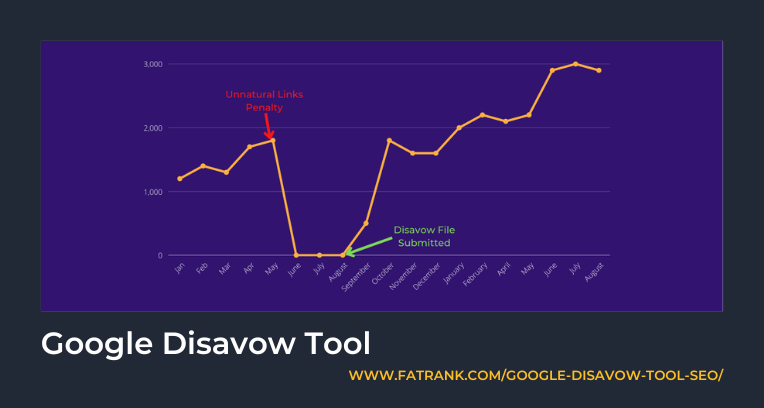
- Google Unnatural Links Penalty
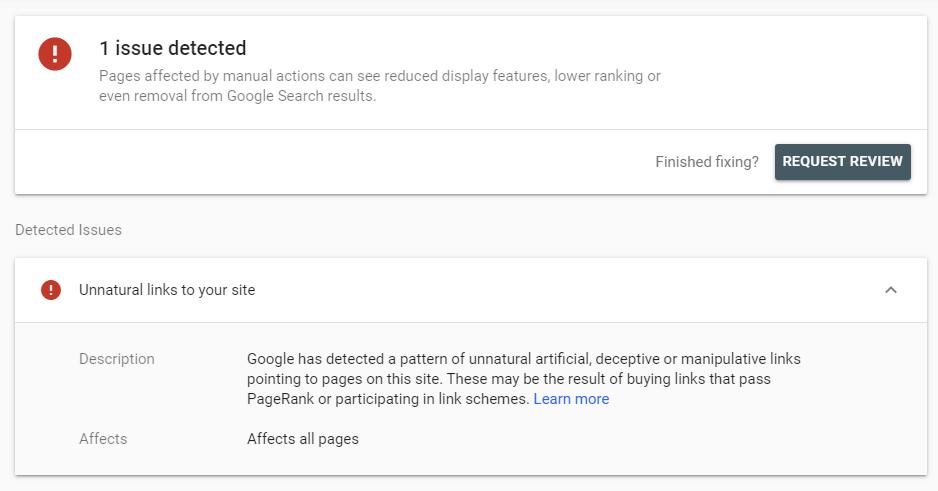
- Link Audit Service
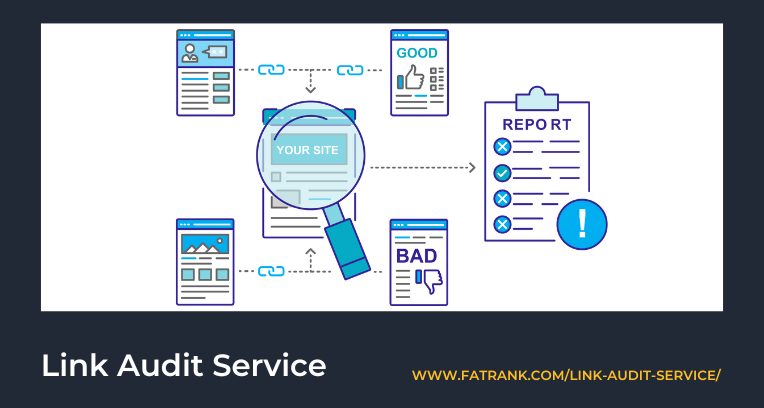
- Link Detox Boost

- Link Detox Rules

- Link Research Tools Review

- Manual Action Removal
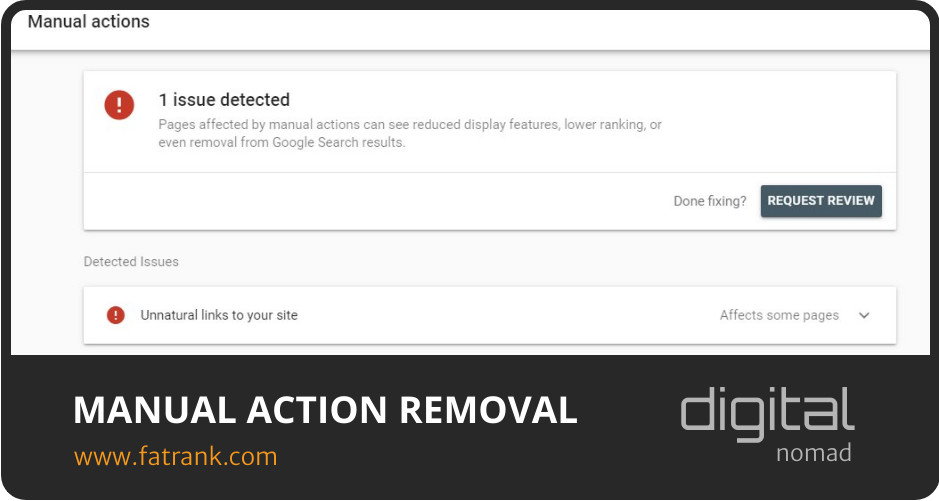
- Types of Google SEO Penalties
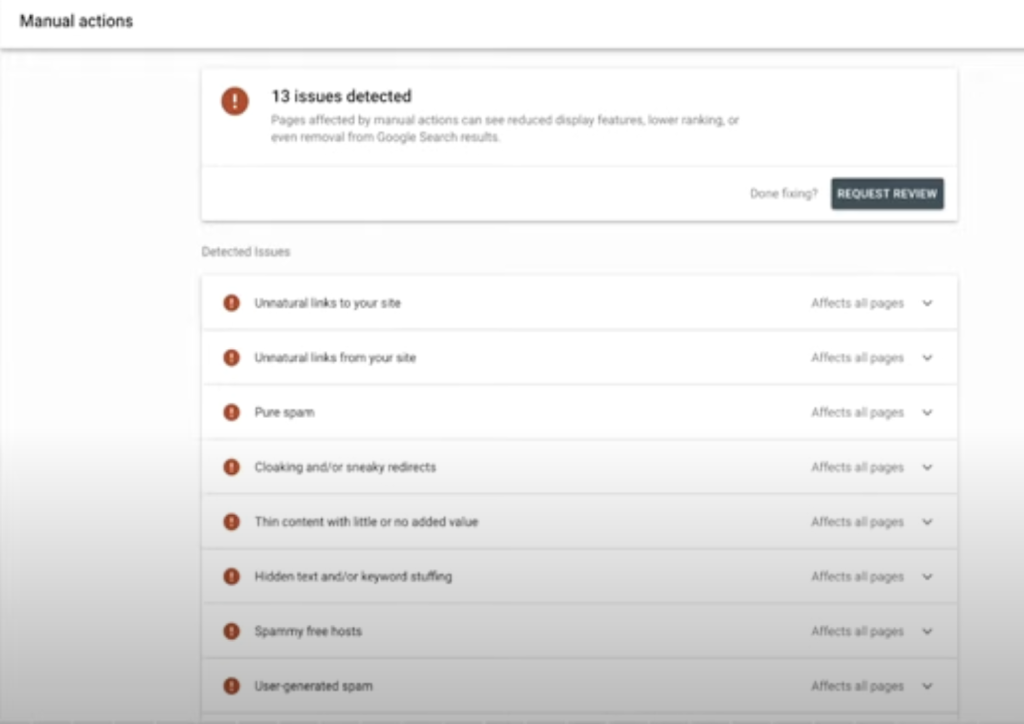
- Unnatural Inbound Links Penalty
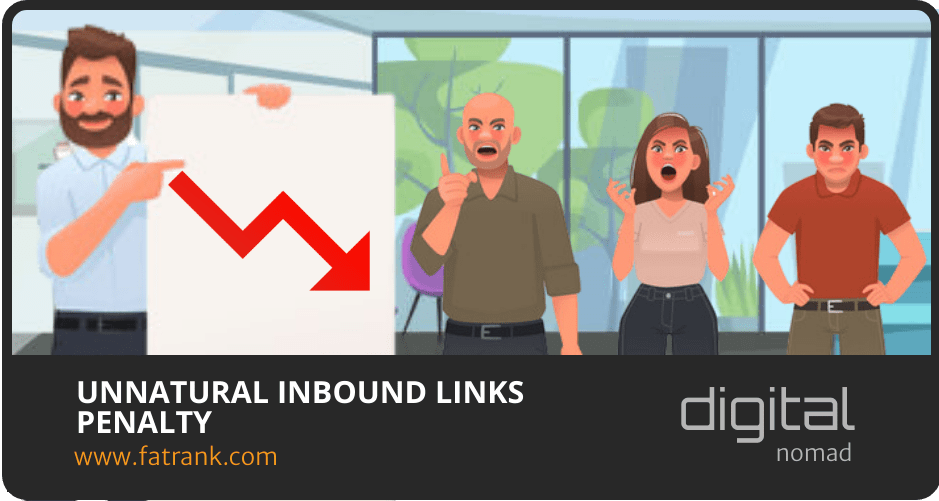
- Will Disavowing Links Help My SEO Strategy in 2023?

The list of articles show everything you need to know about removing dangerous backlinks that could be penalising your website in April 2025.

About FatRank
Our aim to explain and educate from a basic level to an advanced on SEO and Social Media Marketing.
